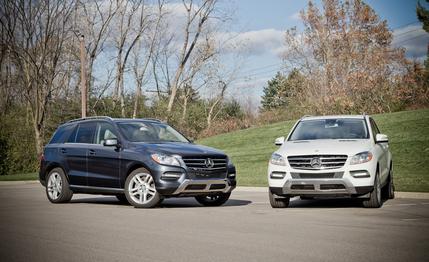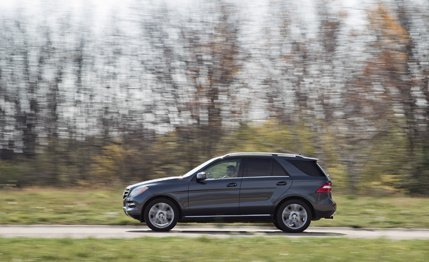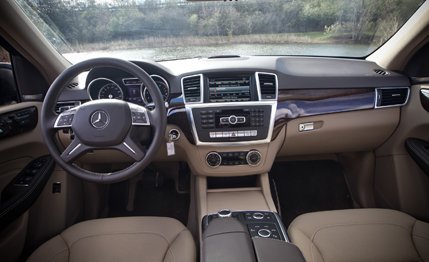
 Instrumented Test
Instrumented Test


Now in its third generation, the M-class has gone from the risky startup enterprise of 1997—new vehicle, new workforce, new U.S. assembly plant—to a solidly established luxury SUV with an increasingly firm grip on a market segment it helped to create.
It doesn’t take a lot of seat time to understand the appeal. Whether all four tires are scratching terra firma or just the rears, the latest ML ups the ante in the areas that count: ritzier interior, quiet operation, smooth ride, more power, more mpg, more room.
There’s also more ML. Compared with its predecessor’s measurements, the 114.8-inch wheelbase is about the same, but overall length increases almost an inch, to 189.1, and width expands 1.5 inches, to 75.8. At 70.7 inches, the roof is closer to mother earth by almost an inch, but then so is the undercarriage—ground clearance for the latest ML350 decreased by almost three inches, to 5.4, which tells you something about the priority of off-road use in the gen-three design. This here is an urban cowboy.


One other increase is at the scales. In our May 2007 comparison test, an ML350 4MATIC weighed 4886 pounds. Not exactly svelte, but the 2013 4MATIC test vehicle tipped the scales at 5023, 340 more pounds than the 2013 rear-drive ML350 in this twin test.
Manageable Mass
So, more mass. But the updated powertrain makes light of it. The displacement of the ML350’s DOHC 24-valve aluminum V-6 is still 3498 cc, but its feeding regimen has changed; direct fuel injection replaces the previous port-injection system. The new diet produces noticeable results. Horsepower is up 34, to 302, and torque increases by 15 lb-ft, to 273.
Better yet, in an era of unprecedented mpg consciousness, EPA fuel-economy ratings are up, too—18 mpg city and 23 highway for both the rear-drive and 4MATIC versions of the 2013 model versus 17/22 for the previous generation (it was available only in 4MATIC form). We logged roughly 1000 miles with our ML350 test vehicles, averaging 19 mpg with the rear-driver and 18 mpg with the 4MATIC.


Put that 1-mpg distinction down to the difference in curb weight, which also shows up on the acceleration charts. The rear-drive ML sprinted to 60 mph in 6.4 seconds and ran the quarter-mile in 14.9 at 94 mph. The 4MATIC needed 6.7 seconds to hit 60 and covered 440 yards in 15.1 seconds at 93 mph. We should add that the rolling-acceleration numbers—5-to-60 mph, 30-to-50 mph, etc.—were about the same for both MLs. And we should add further that the 4MATIC’s sprints were significantly quicker than those of the gen-two version—almost a half-second to 60—that contended in our 2007 comparo.
No-Drama Dynamics
The gen-two MLs were all about quiet comfort, and the gen threes are more so. Suspension travel is abundant, and the pneumatic components tuned to make driving down a stairway feel like a cruise through the park. That characteristic is augmented by excellent straight-line stability, and at freeway speeds the interior is as quiet as certain election headquarters were at about 11:13 p.m. EST last November 6.